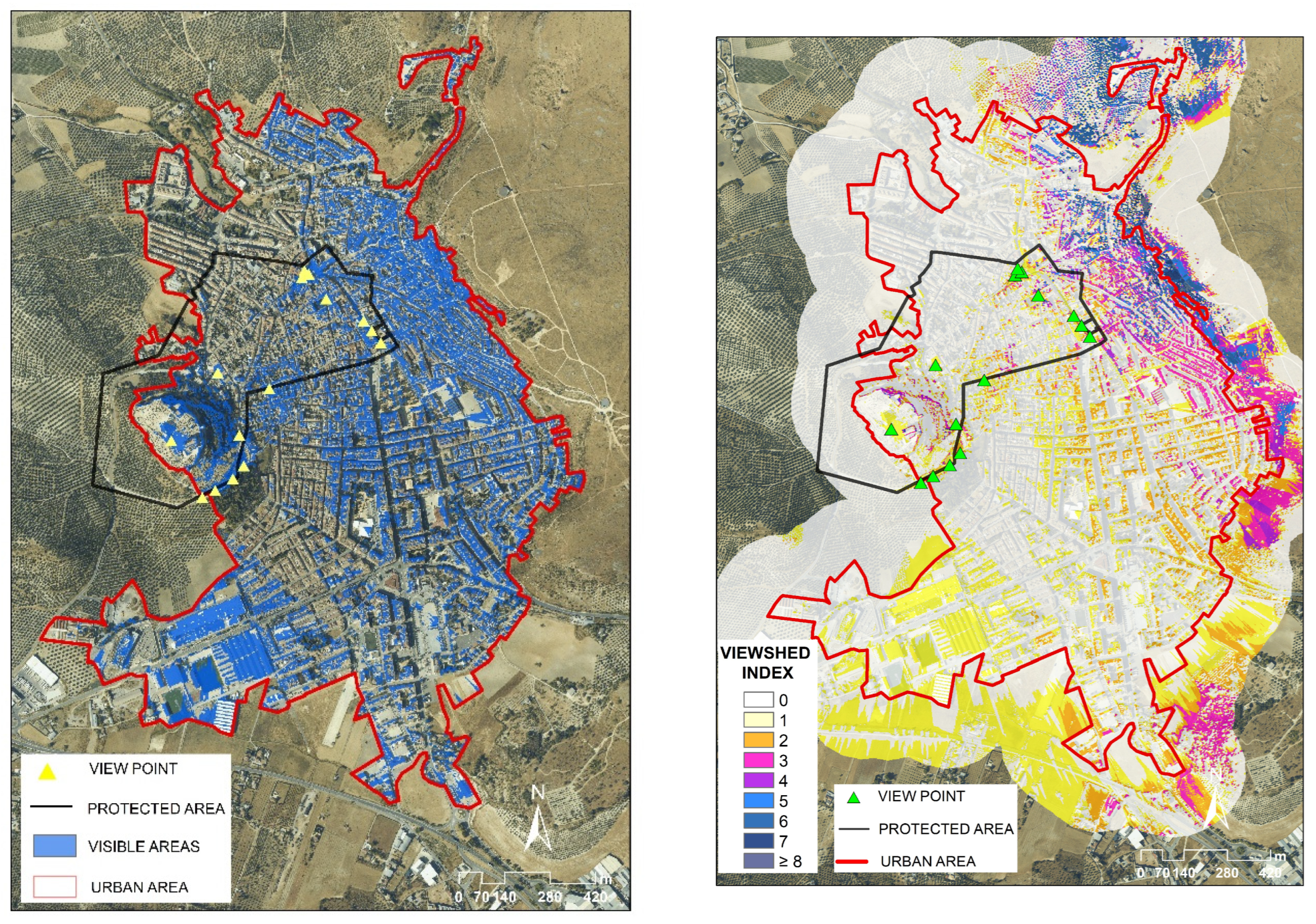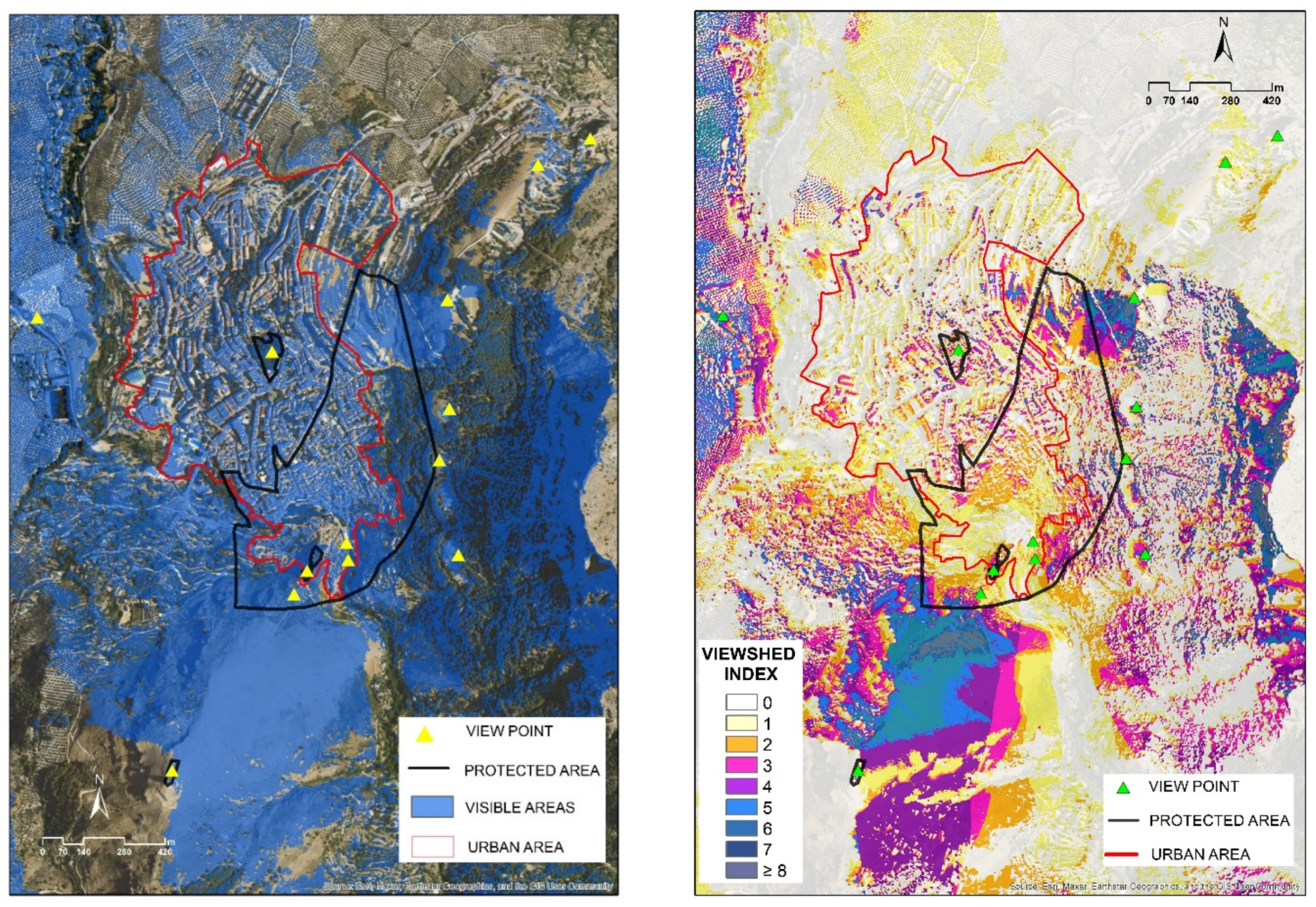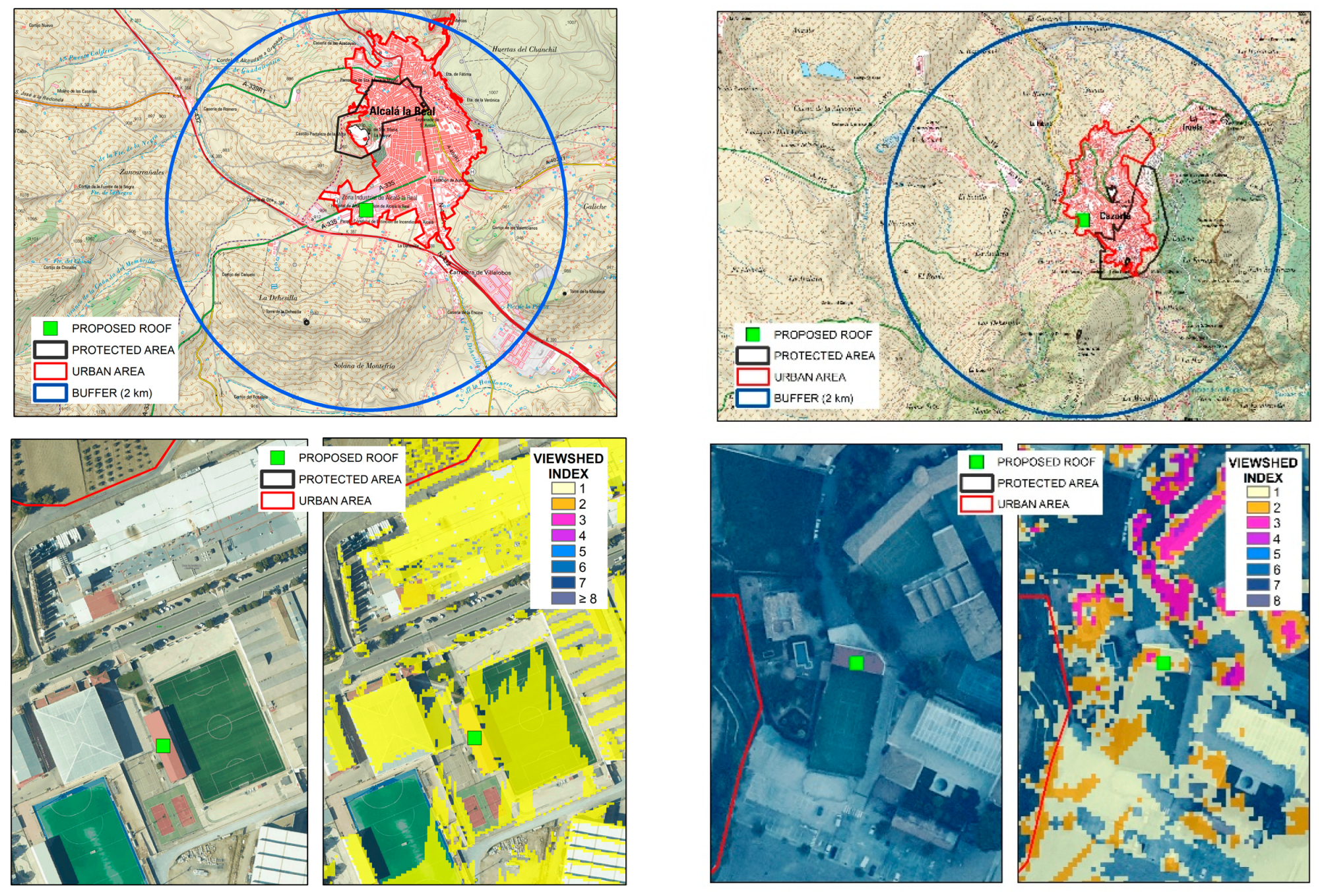Energy Transition and Heritage in Anthropocene Era—Proposal for a Methodological Analysis at Local Scale
Abstract
1. Introduction
2. Materials and Methods
3. Results
3.1. Bibliographic and Regulatory Review
3.2. Socioeconomic and Energy Consumption Analysis
3.3. Analysis of Cultural Heritage and Historical-Architectural Characterization
3.3.1. Alcalá la Real
Cultural Heritage
Historical-Architectural Characterization
3.3.2. Cazorla
Cultural Heritage
Historical-Architectural Characterization
3.4. Protected/Unprotected Cultural Areas
3.5. Visibility Study and Strategic Planning
- Characterization of visible and non-visible zones: This analysis allows for identifying which parts of the urban and heritage which areas can be seen from one of the key points, such as viewpoints or prominent monuments, as applicable. These points were checked with local stakeholders. This study is essential to determine locations where the integration of renewable energies, such as rooftop solar panels, can be carried out with minimal visual impact.
- Analysis of the number of points from which each area is visible: This analysis quantifies the visibility degree of each area by calculating the number of observation points from which it can be seen. The results enable the classification of zones according to their visual exposure facilitating the assessment of their suitability for rooftop renewable energy installations. Priority is given to areas with lower visual exposure to minimize potential interference with the urban and heritage landscape, ensuring a balanced integration of renewable energy solutions within culturally significant environments.
4. Proposed Measures for Integration and Location of Energy Communities
4.1. Alcalá la Real
4.1.1. Protected Zones
- General Restrictions: Photovoltaic solar installations are generally not permitted on protected assets, such as the Castillo de la Mota and the historical ensemble, unless detailed studies confirm their seamless integration and demonstrate no adverse effects on cultural heritage. In such cases, prior authorization from the competent cultural authority is required.
- Preferred Locations: Installations should be prioritized in interior courtyards, secondary or rear-facing roofs that are not visible from key viewpoints. Areas of low visual exposure, as identified through visibility analyses should be favored. Additionally, visual camouflage techniques should be employed to minimize the visibility of installations from elevated vantage points, ensuring that they do not disrupt the urban landscape’s aesthetic coherence.
- Installation Characteristics: Solar tiles that replicate traditional materials should be used, while transparent solar panels may be considered for windows. Photovoltaic panels should have matte finishes and colors that blend with the municipality’s conventional building materials.
- Protection of Original Elements: The alteration of original architectural features, such as traditional tiled roofs, is prohibited unless explicitly authorized in specific cases.
- Approval Process: All installation proposals must receive approval from the Andalusian Cultural Department or the relevant cultural authority, in addition to municipal authorization. Furthermore, an architectural integration project must be submitted for review by the appropriate bodies
4.1.2. Unprotected Zones
- Flexibility and Visibility: Although these areas offer greater flexibility, their visibility from elevated points, particularly from the Castillo de la Mota, necessitates he application of aesthetic compatibility criteria.
- Visual Harmony: Although more leniency is permitted, installations must be designed to maintain urban visual harmony. Greater flexibility is allowed in the industrial and commercial sector on the southwestern flank due to its ongoing transformation.
- Preferred Locations: Priority should be given to south or southwest-facing roofs with minimal visibility from major roads. Flat roofs and large surfaces on modern or industrial buildings, particularly those outside direct sightlines from key viewpoints, should also be considered. Installations should feature matte finishes and color tones that prevent strong reflections or stark contrasts with the surrounding environment.
- Community Solar Plants: Community solar plants should be installed on the roofs of public municipal buildings in unprotected areas with low visual exposure (e.g., near the Castle’s viewpoints) to minimize their impact on heritage sites.
- Installation Characteristics: Aesthetic guidelines should be followed, ensuring that installations incorporate matte finishes and colors that blend with the surrounding landscape to prevent strong reflections or visual disruptions. Conventional solar panels should be used on flat roofs and modern structures, with designs adapted to the building’s form and volume (3–5 cm) to minimize their visual impact. In protected areas, integrated technologies such as solar tiles, solar glass, or transparent panels that replicate traditional materials and respect the existing architectural typology are recommended.
- Strategic Planning and Feasibility Study: A feasibility study was conducted to identify strategic locations for collective self-consumption infrastructure mainly on the roofs of public municipal buildings outside the historical centre. The goal is to facilitate the development of local energy communities and concentrate installations in areas where the visual perception of the heritage is not affected. One such location is the southwestern sector of the urban area that concentrates most of the public-use facilities (services, commercial, and industrial), characterized by a modern and functional construction typology distinct from the traditional protected urban core. Within this sector, the proposed installation site is the roof of an auxiliary building adjacent to the paddle courts, near the municipal swimming pool, as shown in Figure 3 (left). This location was selected to minimize both aesthetic and cultural impact while optimizing energy production and community benefits.
4.2. Cazorla
4.2.1. Protected Zones
- General Restrictions: Photovoltaic solar installations are generally not permitted unless detailed studies demonstrate their proper integration and confirm the absence of any adverse impact on cultural heritage.
- Preferred Locations: Priority should be given to installing solar systems in interior courtyards, on secondary or rear-facing roofs that are not visible from key viewpoints. Installations should be avoided in areas with high visual exposure, as identified through visibility analysis. Additionally, efforts should be made to minimize the visibility of installations from tourist routes or viewpoints.
- Installation Characteristics: Use solar tiles that replicate the appearance for the original materials; integrates transparent solar panels into windows; and employ panels with matte finishes and colors hat closely match the municipality’s traditional materials.
- Protection of Original Elements: Maintaining the visual integrity of the facades is essential, ensuring that the solar panels are not visible from main streets or plazas.
- Reversibility: Installation systems should be designed for easy removal without affecting the original structures.
- Approval Process: Any installation requires explicit approval from the relevant cultural authority, with a preference for collective installations located outside the protected zone.
4.2.2. Unprotected Zones
- Flexibility and visibility: Although the unprotected areas of Cazorla offer greater flexibility for solar installations, their visibility from elevated points—such as natural vantage points overlooking the historic centre—requires strict application of aesthetic compatibility criteria.
- Visual harmony: Although unprotected areas allow for greater design flexibility, installations should be designed to maintain the overall visual harmony of the urban environment, giving priority to the low visibility areas identified in the analysis. In areas characterised by modern, functional buildings that contrast with the historic core, a balance must be struck to avoid visual disturbance.
- Preferred locations: Priority should be given to south or south-west facing rooftops with minimal visibility from main roads and tourist viewpoints. Consideration should also be given to flat roofs and large areas of modern or industrial buildings located out of direct sightlines of major heritage sites. Installations should have matt finishes and colours that avoid strong reflections or sharp contrasts with the surrounding landscape.
- Community solar plants: It is recommended that community solar plants be installed on the roofs of municipal public buildings, in unprotected areas with low visual exposure, thus supplying both protected and unprotected areas and minimising the impact on heritage.
- Installation characteristics: Aesthetic guidelines should be followed, ensuring that installations incorporate matt finishes and colours that blend in with the surroundings. On flat roofs and modern structures, conventional solar panels should be used, with designs adapted to the shape and volume of the building (3–5 cm) to minimise visual impact. On the other hand, in protected areas, integrated technologies such as solar shingles, solar glass or transparent panels that mimic traditional materials and respect the existing architectural typology are recommended.
- Strategic Planning and Feasibility Study: A feasibility study should identify strategic locations for collective self-consumption infrastructure—especially on the roofs of public municipal buildings outside the historic center. In Cazorla, focusing on peripheral areas with lower visual exposure ensures that installations optimize energy production and community benefits while preserving the aesthetic and cultural integrity of the heritage sites.
5. Discussion
6. Conclusions
Author Contributions
Funding
Data Availability Statement
Acknowledgments
Conflicts of Interest
Abbreviations
| CO2 | Carbon dioxide |
| EU | Europe |
| LECs | Local Energy Communities |
| RDL | Royal Decree-Law |
| RD | Royal Decree |
| BIPV | Architecturally Integrated Photovoltaic Systems |
| PGOU | General Urban Development Plan |
| NNSS | Subsidiary Regulations |
| LOUA | Andalusian Urban Planning Law |
| SIMA | Multi-territorial Information System of Andalusia |
| DSM | Digital Surface Models |
| GIS | Geographic Information Systems |
References
- Steffen, W.; Crutzen, P.J.; McNeill, J.R. The Anthropocene: Are humans now overwhelming the great forces of nature. AMBIO J. Hum. Environ. 2007, 36, 614–621. [Google Scholar] [CrossRef]
- Estok, S.C.; Chou, S.S. Foreword: The city and the Anthropocene. Concentric Lit. Cult. Stud. 2017, 43, 3–11. [Google Scholar] [CrossRef]
- Pincetl, S. Cities in the age of the Anthropocene: Climate change agents and the potential for mitigation. Anthropocene 2017, 20, 74–82. [Google Scholar] [CrossRef]
- Girardet, H. Creating Regenerative Cities; Routledge: London, UK, 2014. [Google Scholar]
- Woo, F.; Wortmann, J.; Schurig, S.; Leidreiter, A. Regenerative Urban Development: A Roadmap to the City We Need; World Future Council: Hamburg, Germany, 2014. [Google Scholar]
- Newman, P.; Beatley, T.; Boyer, H. Resilient Cities: Overcoming Fossil Fuel Dependence; Island Press: Washington, DC, USA, 2017. [Google Scholar]
- Alexander, S.; Gleeson, B. Degrowth in the Suburbs. A Radical Urban Imaginary; Palgrave Macmillan: London, UK, 2019. [Google Scholar]
- Lois-González, R.C.; Escudero-Gómez, L.A.; González-Pérez, J.M. Urbanisation and the Anthropocene: The Necessary Transition Towards Regenerative and Sustainable Cities. In Geography and the Anthropocene; Gönençgil, B., Meadows, M.E., Eds.; Istanbul University Press: Istanbul, Türkiye, 2024; pp. 113–150. [Google Scholar]
- Márquez-Sobrino, P.; Díaz-Cuevas, P.; Pérez-Pérez, B.; Gálvez-Ruiz, D. Twenty years of energy policy in Europe: Achievement of targets and lessons for the future. Clean Technol. Environ. Policy 2023, 25, 2511–2527. [Google Scholar] [CrossRef]
- Díaz-Cuevas, P.; Orozco-Frutos, G.; Prieto Campos, A.; Pérez-Pérez, B. Geografía de la energía solar en Andalucía (Sur de España): Nuevos datos y posibilidades de análisis. Cuad. Geográficos 2023, 62, 160–180. [Google Scholar] [CrossRef]
- Pérez-Pérez, B.; Díaz-Cuevas, P.; Martín Peinado, F. La energía solar:¿ Un nuevo uso ordinario del medio rural? Ocupación de suelos agrícolas en el sur de España. Hábitat y Sociedad. 2024, 17, 45–61. [Google Scholar] [CrossRef]
- EU Directive 2018/2001 of the European Parliament and of the Council of 11 December 2018. Available online: https://www.boe.es/doue/2018/328/L00082-00209.pdf (accessed on 15 March 2025).
- EU Directive 2019/944 Directiva (UE) 2019/944 of the European Parliament and of the Council of 5 June 2019. Available online: https://www.boe.es/doue/2019/158/L00125-00199.pdf (accessed on 15 March 2025).
- Royal Decree-Law 15/2018, of October 5, on Urgent Measures for the Energy Transition and Consumer Protection. Available online: https://www.boe.es/boe/dias/2018/10/06/pdfs/BOE-A-2018-13593.pdf (accessed on 15 March 2025).
- Royal Decree 244/2019, of April 5, Regulating the Administrative, Technical and Economic Conditions of Electric Energy Self-Consumption. Available online: https://www.boe.es/boe/dias/2019/04/06/pdfs/BOE-A-2019-5089.pdf (accessed on 15 March 2025).
- Royal Decree-Law 20/2022, of December 27, on Measures to Respond to the Economic and Social Consequences of the Ukraine War and to Support the Reconstruction of La Palma and Other Vulnerable Situations. Available online: https://www.boe.es/buscar/pdf/2022/BOE-A-2022-22685-consolidado.pdf (accessed on 15 March 2025).
- Lucchi, E. Integration between photovoltaic systems and cultural heritage: A socio-technical comparison of international policies, design criteria, applications, and innovation developments. Energy Policy 2022, 171, 113303. [Google Scholar] [CrossRef]
- Di Rocco, A.R.; Bottino-Leone, D.; Troi, A.; Herrera-Avellanosa, D. Application of the Guidelines for the Integration of Photovoltaics in Historic Buildings and Landscapes to Evaluate the Best Practices of the Historic Building Energy Retrofit Atlas. Buildings 2024, 14, 499. [Google Scholar] [CrossRef]
- Fara, L.; Crăciunescu, D.; Diaconu, A.; Chilibon, I.; Badea, A.M.; Fara, S. Advanced architectural integration of aesthetic, energetic and reliable features for coloured building integrated photovoltaic (BIPV) systems. Environ. Eng. Manag. J. EEMJ 2024, 23, 685–701. [Google Scholar] [CrossRef]
- He, T.; Ma, T.; Bläsi, B.; Li, Z.; Li, S.; Chen, Y. Design of periodic dielectric multilayer thin films for colorizing PV panels. Solar Energy 2024, 278, 112655. [Google Scholar] [CrossRef]
- Andalusian Historical Heritage Law 14/2007, of November 26, on the Historical Heritage of Andalusia. Available online: https://www.boe.es/buscar/pdf/2008/BOE-A-2008-2494-consolidado.pdf (accessed on 15 March 2025).
- Ziozas, N.; Kitsopoulou, A.; Bellos, E.; Iliadis, P.; Gonidaki, D.; Angelakoglou, K.; Nikolopoulos, N.; Ricciuti, S.; Viesi, D. Energy Performance Analysis of the Renovation Process in an Italian Cultural Heritage Building. Sustainability 2024, 16, 2784. [Google Scholar] [CrossRef]
- Walker, G.; Simcock, N.; Smith, S.J. Community energy systems. In International Encyclopedia of Housing and Home; Elsevier Science: Oxford, UK, 1; 2012; pp. 194–198. [Google Scholar] [CrossRef]
- Ruggiero, S.; Martiskainen, M.; Onkila, T. Understanding the scaling-up of community energy niches through strategic niche management theory: Insights from Finland. J. Clean. Prod. 2018, 170, 581–590. [Google Scholar] [CrossRef]
- Weis, L.; Becker, S.; Naumann, M. Energiedemokratie: Grundlage UndPerspective Einer Kritischen Energieforschung; Rosa Luxemburg Stiftung: Berlin, Germany, 2015. [Google Scholar] [CrossRef]
- Angel, J. Towards Energy Democracy: Discussions and Outcomes from an Inter-National Workshop; Rosa Luxemburg Foundation: Amsterdam, The Netherlands, 2016; Available online: http://www.rosalux.eu/fileadmin/user_upload/Publications/energy_democracy_ws_report_web.pdf (accessed on 15 March 2025).
- Venice Charter. International Charter on the Conservation and Restoration of Monuments and Sites. 2004. Available online: https://www.icomos.org/venicecharter2004 (accessed on 15 March 2025).
- Article 167 of the Treaty on the Functioning of the, EU. Available online: https://www.legislation.gov.uk/eut/teec/article/167#:~:text=1.The%20Union%20shall%20contribute%20to%20the%20flowering%20of,bringing%20the%20common%20cultural%20heritage%20to%20the%20fore (accessed on 15 March 2025).
- Spanish Historical Heritage Law 16/1985. Law 16/1985, of June 25, on Spanish Historical Heritage; Official State Bulletin; 20342-20352; 155p. Available online: https://www.boe.es/eli/es/l/1985/06/25/16/con (accessed on 2 April 2025).
- General Urban Development Plan (PGOU) of Alcalá la Real. Available online: https://transparencia.alcalalareal.es/obras-publicas-y-urbanismo/ (accessed on 15 March 2025).
- Partial adaptation of its Subsidiary Regulations (NNSS) to the General Urban Development Plan (PGOU) Cazorla. Available online: https://cazorla.es/wp-content/uploads/2015/02/Expediente-del-PGOU-adaptaci%C3%B3n-parcial-de-las-Normas-Subsidiarias-a-la-LOUA-de-Cazorla.pdf (accessed on 15 March 2025).
- Law (LOUA) 7/2002, of December 17, on Urban Planning in Andalusia. Available online: https://www.boe.es/buscar/act.php?id=BOE-A-2003-811 (accessed on 15 March 2025).
- Multi-Territorial Information System of Andalusia (SIMA). Available online: https://www.juntadeandalucia.es/institutodeestadisticaycartografia/dega/sistema-de-informacion-multiterritorial-de-andalucia-sima (accessed on 15 March 2025).
- Multi-Territorial Information System of Andalusia (SIMA)—Alcalá la Real. 2024. Available online: https://www.juntadeandalucia.es/institutodeestadisticaycartografia/sima/ficha.htm?mun=23002 (accessed on 15 March 2025).
- Multi-territorial Information System of Andalusia (SIMA)—Cazrola. 2024. Available online: https://www.juntadeandalucia.es/institutodeestadisticaycartografia/sima/ficha.htm?mun=23028 (accessed on 15 March 2025).
- General Catalog of Adndalusian Historical Heritage. Available online: https://www.juntadeandalucia.es/organismos/culturaydeporte/areas/cultura/bienes-culturales/catalogo-pha.html (accessed on 15 March 2025).
- National Geographic Institute. Digital Surface Model of Spain 2 × 32 m. In Metadata Catalogue of the Spatial Data Infrastructure of Spain—CNIG on behalf of the Higher Geographical Council; Geological and Mining Institute of Spain: Madrid, Spain, 2010. [Google Scholar]
- Pellicer, I.; Estornell Cremades, J.; Martí, J. Aplicación de datos LiDAR aéreo para el cálculo de cuencas visuales. Rev. Teledetección 2014, 41, 9–18. [Google Scholar]
- Rubio, A.M. Energía Solar Fotovoltaica Integrada en la Edificación: Modelizado y Análisis del Efecto del Sombreado en la Captación de Irradiación. Ph.D. Dissertation, Universidad de La Rioja, Logroño, Spain, 2016. [Google Scholar]
- Tsoumanis, G.; Formiga, J.; Bilo, N.; Tsarchopoulos, P.; Ioannidis, D.; Tzovaras, D. The smart evolution of historical cities: Integrated innovative solutions supporting the energy transition while respecting cultural heritage. Sustainability 2021, 13, 9358. [Google Scholar] [CrossRef]
- Pérez-Pérez, B. Comunidades energéticas en barrios patrimoniales: Comunidad Energética (CE) Barrios de La Alhambra (Granada). Revista de Estudios. Andaluces. 2023, 46, 102–125. [Google Scholar] [CrossRef]
- Gao, D.; Mo, X.; Xiong, R.; Huang, Z. Tax policy and total factor carbon emission efficiency: Evidence from China’s VAT reform. Int. J. Environ. Res. Public Health 2022, 19, 9257. [Google Scholar] [CrossRef] [PubMed]



Disclaimer/Publisher’s Note: The statements, opinions and data contained in all publications are solely those of the individual author(s) and contributor(s) and not of MDPI and/or the editor(s). MDPI and/or the editor(s) disclaim responsibility for any injury to people or property resulting from any ideas, methods, instructions or products referred to in the content. |
© 2025 by the authors. Licensee MDPI, Basel, Switzerland. This article is an open access article distributed under the terms and conditions of the Creative Commons Attribution (CC BY) license (https://creativecommons.org/licenses/by/4.0/).
Share and Cite
Pérez-Pérez, B.; Chacón-Linares, E. Energy Transition and Heritage in Anthropocene Era—Proposal for a Methodological Analysis at Local Scale. Urban Sci. 2025, 9, 112. https://doi.org/10.3390/urbansci9040112
Pérez-Pérez B, Chacón-Linares E. Energy Transition and Heritage in Anthropocene Era—Proposal for a Methodological Analysis at Local Scale. Urban Science. 2025; 9(4):112. https://doi.org/10.3390/urbansci9040112
Chicago/Turabian StylePérez-Pérez, Belén, and Eva Chacón-Linares. 2025. "Energy Transition and Heritage in Anthropocene Era—Proposal for a Methodological Analysis at Local Scale" Urban Science 9, no. 4: 112. https://doi.org/10.3390/urbansci9040112
APA StylePérez-Pérez, B., & Chacón-Linares, E. (2025). Energy Transition and Heritage in Anthropocene Era—Proposal for a Methodological Analysis at Local Scale. Urban Science, 9(4), 112. https://doi.org/10.3390/urbansci9040112




